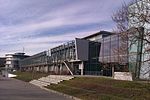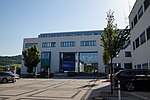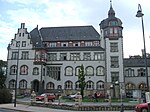Ernst-Abbe-Hochschule Jena
Education in JenaPublic universities and colleges in GermanyUniversities and colleges in ThuringiaUniversities of Applied Sciences in GermanyVocational education in Germany

University of Applied Sciences Jena (UAS Jena) (German: Ernst-Abbe-Hochschule Jena (EAH Jena)) was founded on 1 October 1991 as one of the first institutions of higher education of its kind in the newly founded federal states of Germany. Since the beginning of summer semester 2012, it bears the name of the entrepreneur Ernst Abbe. The university is characterized above all by its high practical orientation and research strength. Their slogan is: Innovation for quality of life. Health, precision, sustainability & networking!
Excerpt from the Wikipedia article Ernst-Abbe-Hochschule Jena (License: CC BY-SA 3.0, Authors, Images).Ernst-Abbe-Hochschule Jena
Carl-Zeiss-Promenade, Jena Lichtenhain (Lichtenhain)
Geographical coordinates (GPS) Address Website External links Nearby Places Show on map
Geographical coordinates (GPS)
| Latitude | Longitude |
|---|---|
| N 50.9189 ° | E 11.5692 ° |
Address
Ernst-Abbe-Hochschule Jena
Carl-Zeiss-Promenade 2
07745 Jena, Lichtenhain (Lichtenhain)
Thuringia, Germany
Open on Google Maps











